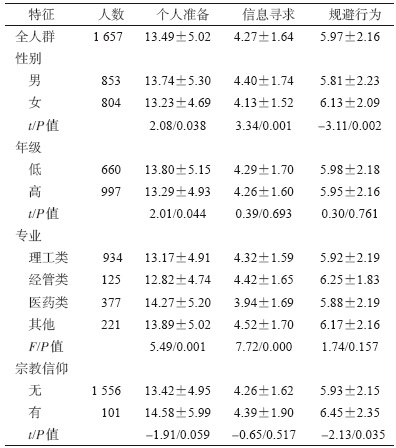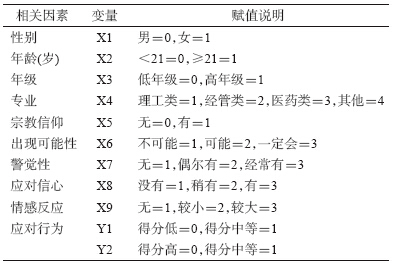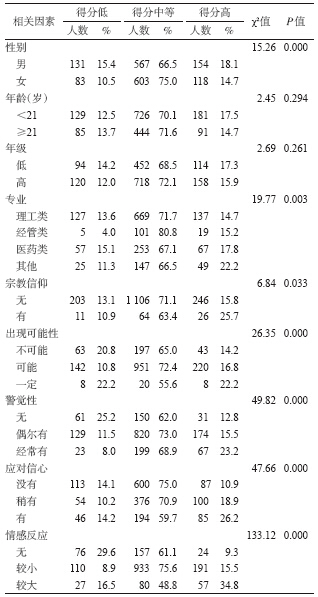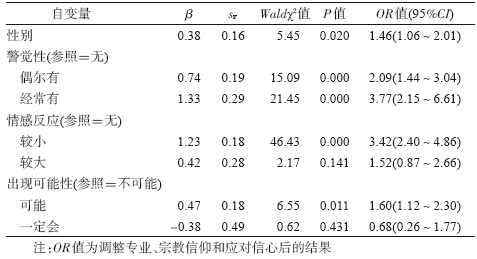文章信息
- 叶云凤, 饶珈铭, 王海清, 张思恒, 李洋, 王声湧, 董晓梅. 2014.
- Ye Yunfeng, Rao Jiaming, Wang Haiqing, Zhang Siheng, Li Yang, Wang Shengyong, Dong Xiaomei. 2014.
- 广州市大学生暴力恐怖袭击应对行为及其影响因素分析
- Analysis on the individual-response behavior and the influence factors to violent terrorist attacks among undergraduates in Guangzhou
- 中华流行病学杂志, 2015, 36(4): 327-331
- Chinese Journal of Epidemiology, 2015, 36(4): 327-331
- http://dx.doi.org/10.3760/cma.j.issn.0254-6450.2015.04.007
-
文章历史
- 投稿日期:2014-09-15
暴力恐怖袭击是指以暴力、恐吓等手段制造社 会恐慌、危害公共安全为目的,造成或意图造成人员 伤亡、重大财产损失等严重社会危害行为[1]。恐怖 袭击从20 世纪90 年代以来,在全球范围内迅速蔓延 且呈急剧上升趋势,造成大规模人员伤亡和社会恐 慌。近年来恐怖活动的客体日趋广泛[2, 3],校园暴力 恐怖袭击事件更是层出不穷[4, 5]。目前社会中存在 随时随地可能发生恐怖袭击的环境[1],做好充分应 对准备是防止恐怖袭击和减小损害后果最有效的手 段之一[6]。暴力恐怖袭击个人应对行为是指在暴力 恐怖袭击发生前个人感知和应对威胁的方式或方 法[7]。近年来国外对暴力恐怖袭击个人应对行为的 相关研究主要针对公众人群,强调认知和情感因素 对个人应对行为的影响,并通过相关量表分析与评 价公众应对暴力恐怖袭击的行为,建立认知-社会模 型[8, 9, 10, 11]。目前我国对恐怖主义的研究主要集中在定 义、特征与犯罪立法等方面,暴力恐怖袭击的认知、 态度与应对行为相关研究较少。为此本研究拟参 考国外暴力恐怖袭击应对行为量表,从大学生对暴 力恐怖袭击的认知角度收集数据,分析该人群对暴 力恐怖袭击的个人应对行为情况及其影响因素。 对象与方法
1. 调查对象:2014 年4-6 月采用分层整群抽样 方法抽取广州市5 所高校不同专业和年级的在读本 科生。首先将专业分为理工、经管、医药、文史艺术 及其他类,根据各校不同专业人数进行分层确定各 校抽样班级数,再考虑年级并进行以班级为单位的 整群抽样,确定应调查的班级。此次调查共抽取20 个班级1 800 名在校全日制大学生。以班级为单位, 由经统一培训的调查人员(医学院高年级本科生)利 用课余时间进行现场调查,当场统一收回问卷。原 始资料经逻辑检查后,剔除不合格问卷。
2. 调查工具:
(1)应对行为量表:参考国内外用以评价公众暴 力恐怖袭击个人应对行为量表[7, 12, 13],并根据我国学 生人群实际情况进行相应修改。修改后的量表 Cronbach’s α为0.82。量表包括13 个条目,由个人 准备行为(8 个条目)、信息寻求行为(2 个条目)和规 避行为(3 个条目)3 个分量表组成,用以评价大学生 对暴力恐怖袭击的个人应对行为。量表采用1(从 不)~5(总是)级评分。分别计算各维度得分,个人 准备行为得分总分为8~40 分,信息寻求行为得分 总分为2~10 分,规避行为得分总分为3~15 分,得 分越高代表个人应对行为越突出。
(2)自编人口学及相关因素调查表:人口学部 分包括年龄、性别、年级、专业、宗教信仰等。相关 因素包括认为出现可能性、警觉性、应对信心和情 感反应。
3. 统计学分析:使用SPSS 13.0 软件分析数据。 计算不同人口学特征大学生的个人准备行为、信息 寻求行为和规避行为得分均值(x)、标准差(s),性 别、年级、宗教信仰比较采用两独立样本t检验,专业 比较采用One-Way ANOWA;对暴力恐怖袭击个人 应对行为单因素分析采用χ2检验,检验水准α=0.10; 采用logistic 回归分析影响暴力恐怖袭击应对行为 的独立因素,检验水准α=0.05。 结果
1. 人口学特征:共发放问卷1 800 份,回收1 757 份,回收率为97.61%,其中有效问卷1 657 份,问卷 有效率为92.06%。样本人群年龄17~28 岁,平均 (21.2±1.7)岁;男生853 人(51.48%),女生804 人 (48.52%);大一至四及以上分别为255、405、660 和 337 人,分别占15.39%、24.44%、39.83%和20.34%; 理工类专业934 人,经管类专业125 人,医药类专业 377 人,文史艺术及其他类专业221 人,分别占 56.37%、7.54%、22.75%和13.34%。
2. 暴力恐怖袭击应对行为得分及分组:分析调 查人群的个人准备行为、信息寻求行为和规避行为 得分,性别间的差异均有统计学意义(P<0.05),除 规避行为得分女生高于男生外,个人准备行为和信 息寻求行为得分男生均高于女生;信教大学生的规 避行为得分高于无信教大学生;医药类专业大学生 的个人准备行为得分明显高于其他专业学生,而信 息寻求行为得分则明显低于其他专业学生(表 1)。 调查人群对暴力恐怖袭击应对行为的得分分布为正 偏态分布,故将应对行为得分进行对数变换,以几何均数表示平均水平。根据统计学上对正态分布数 据的分组方法,将应对行为得分按lg-1(xlg±slg)划 分为得分低(总分<17 分)、中等和高(总分>30 分) 3 个组。得分低组表现为应对行为较淡漠,>70%的 问题选择“从不”;得分高组的个人准备、信息寻求与 规避行为相对较突出(表 2)。
3. 暴力恐怖袭击应对行为的分析:
(1)单因素分析:调查人群对暴力恐怖袭击个人 应对行为的相关因素和赋值见表 3。用X2检验分析 暴力恐怖袭击应对行为的相关因素,检验水准α= 0.10。女生、医药类专业、有宗教信仰、认为出现可 能性越大、警觉性越高、应对信心越强和情感反应越 大是该调查人群暴力恐怖袭击个人应对行为的影响 因素(表 4)。
(2)多因素分析:用似然比前进法筛选因素,检 验水准α=0.05,分别对应对行为得分低组和高组与 中等组进行logistic 回归分析。女生暴力恐怖袭击应 对行为比男生突出;认为出现可能性大、警觉性越高、 自信心增加和情感反应越大,大学生暴力恐怖袭击应 对行为越突出。扣除上述5个因素对该人群暴力恐怖 袭击个人应对行为得分的影响后,年龄、专业、年级和 宗教信仰与暴力恐怖袭击应对行为得分无关(表 5、6)。
国外采用暴力恐怖袭击应对行为量表评价公众 应对暴力恐怖袭击的个人行为。原量表在进行探索 性和验证性因子分析后得出较好的拟合效果(X2= 2 072.61,P<0.001;CFI=0.99;RMSEA=0.33)[12], 中文版暴力恐怖袭击应对行为量表Cronbach’s α为 0.82,因子分析结果各条目共性方差均大于0.30,因 此量表所有条目不考虑调整或删除。本文采用中文 版暴力恐怖袭击应对行为量表,从个人准备行为、信 息寻求行为和规避行为3 个方面评价与分析大学生 人群暴力恐怖袭击个人应对行为,并从认知、情感反 应角度分析影响因素。
本次调查结果显示,不同性别、专业和有无宗教 信仰大学生的个人准备行为、信息寻求行为和规避 行为存在差异。性别间的差异与国外同类研究结论 一致[8, 10]。由于学科性质的不同,医药类专业大学生 在学习专业课程时更容易接触自救互救知识与技 能,个人准备行为也会较突出。宗教信仰能对大学 生的思想和行为产生影响[14],有宗教信仰的学生倾 向于有较突出的规避行为,其原因需进一步探索。
分析发现,认知因素是个人应对行为的独立影 响因素,并通过情感反应间接影响应对行为,与认 知-社会模型的结论一致。多因素logistic 回归分析 结果提示,该调查人群认为暴力恐怖袭击出现可能 性越大、警觉性越高、应对信心越强和情 感反应越大,暴力恐怖袭击个人应对行为 越突出,与Lee 和Lemyre[7]的研究结论相 符。本研究对出现可能性、警觉性、应对 信心与情感反应进行双变量相关分析,结 果提示认知因素与情感反应有关联。因 此,推测认知因素可以通过情感反应间接 影响应对行为。还发现恰当的情感反应 有利于大学生的个人应对行为,反之则会 导致个人准备行为、信息寻求行为和规避 行为过于突出,不利于大学生的身心健康 与社会关系的建立。
本研究存在不足。一是问卷内容只 涉及认知与情感因素,未考虑社会人际因 素,认知-社会模型不完整;二是与国外采 用多元线性回归分析方法相比,对应对行 为按量表得分分组分析,将计量资料降级 为计数资料,损失了一定的样本信息。需 要在后续的研究问卷中增加社会人际因 素模块,丰富研究结果。
已有研究表明,警觉性有助于促进自救互救知 识技能学习[15, 16, 17, 18, 19],应对信心的强弱更是影响自救知 识技能学习动力的关键因素[20, 21]。而国内相关研究 表明[22, 23],各地大学生对突发事件的认知与应对能力 相对欠缺,在高校建立危机教育的“常态教育”模式, 开展危机管理教育和技能训练已是当务之急[24]。各 大高校可以通过开展讲座、开设课程、定期防灾演练 等方式开展暴力恐怖袭击知识的宣传教育,增强大 学生的防范意识及应对突发事件的信心,防止防范 意识过度造成不必要的心理负担及恐慌。
| [1] Wang SY. Violent terrorist attacks and countermeasures [J]. Injury Med, 2014, 3(2):4-8. (in Chinese)王声湧. 暴力恐怖袭击及其应对[J]. 伤害医学, 2014, 3(2):4-8. |
| [2] Li JH, Wang CK, Mei JM, et al. The character and new tendency of the contemporary terrorism[J]. J Chin People's Public Security Univer:Soc Sci Ed, 2008, 24(3):1-7. (in Chinese)李健和, 王存奎, 梅建明, 等. 当代恐怖主义的特征与发展趋势 [J]. 中国人民公安大学学报:社会科学版, 2008, 24(3):1-7. |
| [3] Zhang JD. On global terrorism activities in 2006[J]. Teach Res, 2007(5):73-81. (in Chinese)张家栋. 2006 年世界恐怖活动状况述评[J]. 教学与研究, 2007(5):73-81. |
| [4] Chen K. Analysis of the ideology of young people's involvement in terrorism[J]. Contemp Young Res, 2010(7):18-25.(in Chinese)陈锴. “愤青”与恐怖主义——试析青年参与恐怖活动的意识形态因素[J]. 当代青年研究, 2010(7):18-25. |
| [5] Chen S. Inestimable crisis population in university under the shadow of terrorism—an investigation of population management in colleges and universities [J]. Policy Res Explorat, 2006(5):56-57. (in Chinese)陈韶. 恐怖主义阴影下高校危机人口的不可估量性——高校人口管理调查[J]. 决策探索, 2006(5):56-57. |
| [6] Federal Emergency Management Agency. National Response Framework(second edition)[R/OL]. [2014-07-15]. Resources: http://www.fema.gov/national-response-framwork. |
| [7] Lee JEC, Lemyre L. A social-cognitive perspective of terrorism risk perception and individual response in Canada[J]. Risk Anal, 2009, 29(9):1265-1280. |
| [8] Eisenman DP, Wold C, Fielding J, et al. Differences in individual-level terrorism preparedness in Los Angeles county[J]. Am J Prev Med, 2006, 30(1):1-6. |
| [9] Fischhoff B, de Bruin WB, Perrin W, et al. Travel risks in a time of terror:judgments and choices[J]. Risk Anal, 2004, 24(5):1301-1309. |
| [10] Goodwin R, Willson M, Stanley G Jr. Terror threat perception and its consequences in contemporary Britain [J]. Br J Psychol, 2005, 96(4):389-406. |
| [11] Huddy L, Feldman S, Capelos T, et al. The consequences of terrorism:disentangling the effects of personal and national threat[J]. Polit Psychol, 2002, 23(3):485-509. |
| [12] Lee JEC, Gibson S, Markon MPL, et al. A preventive coping perspective of individual response to terrorism in Canada [J]. Curr Psychol, 2009, 28(2):69-84. |
| [13] Fang YM, Wang ZH. Research on the prevention of “terrorism” in Sichuan University-Based on partial universities in Sichuan [J]. Chongqing Administration:Public Forum, 2010, 12(3):60-62. (in Chinese)方玉媚, 王治华. 加强四川高校对“恐怖主义”防范的研究——基于四川部分高校的调查[J]. 重庆行政:公共论坛, 2010, 12(3):60-62. |
| [14] Zuo P, He J. The reason, influence and solution analysis of college students' faith in religions[J]. Stud Ideol Educ, 2009(1):55-59. (in Chinese)左鹏, 何进. 大学生信教的原因、影响及对策分析[J]. 思想教育研究, 2009(1):55-59. |
| [15] Witte K. Theory-based interventions and evaluations of outreach efforts[R/OL]. (2007-03-09)[2014-06-20]. Seattle WA:National Network of Libraries of Medicine Pacific Northwest Region, Outreach Evaluation Resource Center Research Review, 1998. http://nnlm.gov/evaluation/pub/witte/. |
| [16] Weinstein ND. The precaution adoption process[J]. Health Psychol, 1988, 7(4):355-386. |
| [17] Weinstein ND. Testing four competing theories of health protective behaviour [J]. Health Psychol, 1993, 12(4):324-333. |
| [18] Weinstein ND. Perceived probability, perceived severity, and health-protective behavior[J]. Health Psychol, 2000, 19(1):65-74. |
| [19] Weinstein ND, Sandman PM, Roberts NE. Determinants of self-protective behavior:home radon testing[J]. J Appl Social Psy, 1990, 20(10):783-801. |
| [20] Rogers RW. Cognitive and physiological processes in fear appeals and attitude change:a revised theory of protection motivation//Cacioppo J, Petty R Eds. Social Psychophysiol[M]. New York:Guilford Press, 1983:153-176. |
| [21] Rogers RW. A protection motivation theory of fear appeals and attitude change[J]. J Psychol, 1975, 91(1):93-114. |
| [22] Dong XM, Chen XF, Wang SY, et al. Investigation on the cognition and strain capability of sudden disaster for university students [J]. Chin J Public Health, 2006, 22(6):660-661. (in Chinese)董晓梅, 陈雄飞, 王声湧, 等.大学生对突发灾害的认知及应变能力调查[J]. 中国公共卫生, 2006, 22(6):660-661. |
| [23] Wang C, Li WH, Wang SY, et al. Investigation on the cognition, practice and demand of university emergency for university students in Guangzhou[J]. Chin J Sch Health, 2011, 32(7):818-819. (in Chinese)王畅, 李文浩, 王声湧, 等. 广州市大学生高校突发事件认知行为及需求状况调查[J]. 中国学校卫生, 2011, 32(7):818-819. |
| [24] Xiang GR. Characteristics of American crisis education and its enlightenment to China [J]. Data Cultural Educ, 2006(2):183-184. (in Chinese)项光荣. 美国危机教育的特点及对我国的启示[J]. 文教资料, 2006(2):183-184." |
 2015, Vol. 36
2015, Vol. 36








